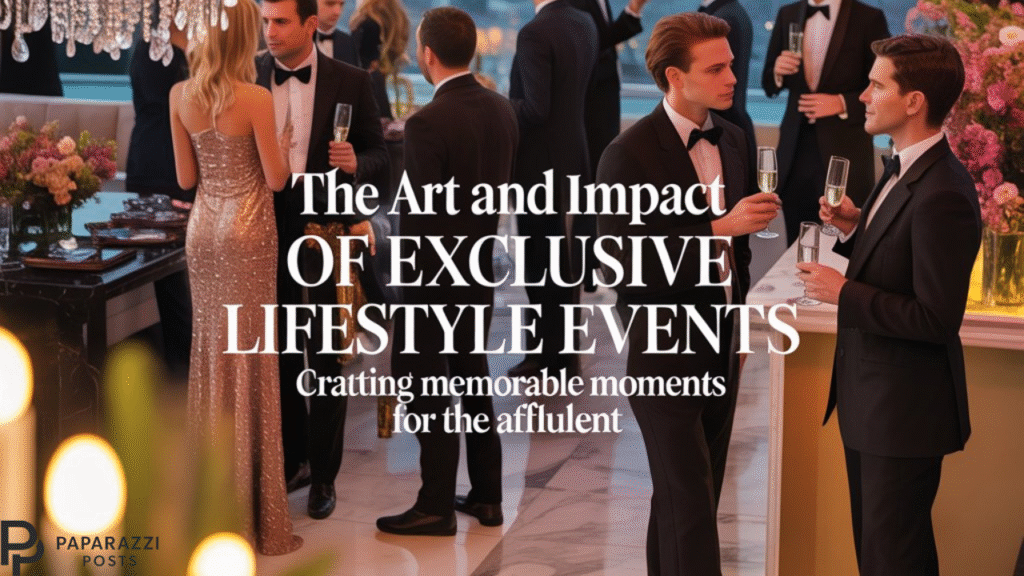When it comes to high-end social gatherings, nothing captures the imagination like exclusive lifestyle events. From invitation-only soirées in New York and Los Angeles to private retreats in the Hamptons or Napa Valley, these curated experiences represent prestige, connection, and status.
The phrase exclusive lifestyle events describes a world of experiential luxury where every detail is customized for the elite. For U.S. professionals, entrepreneurs, and tastemakers, understanding why these events thrive is both a strategy and an art.
Therefore, this post explores exclusive lifestyle events—what defines them, how they’re designed, who attends, and why they matter in modern culture.
What Defines Exclusive Lifestyle Events
At their core, exclusive lifestyle events signal high quality, limited access, and refined experiences. According to luxury service studies, they rely on three types of exclusivity: monetary, social, and hedonic.
Monetary exclusivity refers to high entry costs. Social exclusivity means only select guests are invited, often through referrals. Meanwhile, hedonic exclusivity focuses on emotional satisfaction and sensory pleasure.
For example, a luxury car launch or a chef-led dinner for select watch clients in the U.S. both qualify. The event design—venue, guest list, and privacy—emphasizes that it’s not open to everyone. Consequently, these events feel meaningful, rare, and aspirational.
Why They Matter: The Experiential Turn
In today’s culture, experiences often outweigh possessions. Research shows luxury experiences act as escapes, providing joy, meaning, and social recognition. Within that trend, exclusive lifestyle events stand out. They’re immersive, short-lived, and deeply memorable, helping attendees affirm identity and social standing.
Moreover, studies in luxury marketing reveal that rarity enhances perceived value. Limited-capacity events create stronger emotional and social worth. Thus, these events are not simply lavish—they’re strategically designed to create aspiration and differentiation.
In addition, they connect luxury brands to consumers in an authentic way, offering value beyond products. As a result, attendees often associate these experiences with higher trust and brand loyalty.
Designing an Unforgettable Experience
Creating an unforgettable event starts with the venue and ambiance. The space should feel unique—like a Manhattan penthouse, a California vineyard, or a secluded coastal resort.
Guest curation is equally important. Instead of open registration, these events rely on invitations, referrals, or memberships. This approach ensures that guests reflect the event’s identity and exclusivity.
Moreover, meaningful interactions among guests—shared values, networking, and prestige—add another layer of appeal. When people feel they’re among equals, the experience transforms into social capital.
Experience design goes beyond setting. It includes curated entertainment, personalized service, and immersive themes that heighten emotions.
“People do not just buy the luxury item—they buy the story, the memory, and the status that comes with being part of the rare experience.” — Dr. Jane Holmqvist
By weaving stories, emotions, and connections, hosts create events that feel both intimate and extraordinary. Furthermore, the memories built during such events often strengthen long-term relationships.
Digital Amplification – The Instagram Factor
In the digital era, even exclusive events must plan for online impact. The “Instagrammable moment” is now essential. Guests frequently share glimpses online to showcase their presence and prestige.
For U.S. event planners, professional photography, seamless Wi-Fi, and branded backdrops extend the event’s influence. As a result, prestige spreads beyond the venue, reaching global audiences.
However, balance is key. Too much exposure may dilute exclusivity, while too little may limit influence.
Who Attends and Why
In the U.S., these events attract ultra-high-net-worth individuals, professionals, luxury brand clients, tastemakers, and influencers. They seek status, networking, and one-of-a-kind experiences.
Such events act as status markers—a way to belong and stand apart. Consequently, attending these gatherings helps people position themselves among a select social group.
People attend for several reasons: to meet peers, gain insights, or align with a luxury brand. In addition, each event becomes a social and personal investment that enhances both reputation and self-worth.
Business and Branding Value
For luxury brands and planners, hosting exclusive lifestyle events brings significant strategic benefits. These experiences deepen engagement, showcase premium positioning, and create loyal communities.
Brands gain more than exposure—they build long-term relationships. Guests enjoy tangible and emotional rewards: access, inspiration, and unforgettable memories.
Moreover, such events allow brands to demonstrate authenticity and craftsmanship. Consequently, attendees associate the experience with the brand’s excellence and purpose.
Events like these move brands beyond products. They create shared experiences that strengthen loyalty and elevate identity.
Trends and Future Outlook
Several trends now shape the evolution of these events. Consumers prefer experiences over products. Therefore, event designers must focus on authenticity, purpose, and meaning.
Hybrid models—mixing physical and digital experiences—extend event life. Even elite guests appreciate post-event engagement and online connection.
Furthermore, sustainability and ethics matter more than ever. American luxury consumers want to support events that reflect conscious values. Green venues, charity tie-ins, and inclusivity enhance authenticity and exclusivity.
Technology also enhances personalization. AI guest matching, immersive reality, and smart data insights create tailor-made moments. As a result, luxury experiences feel more human, efficient, and memorable.
Challenges and Pitfalls Worth Avoiding
Exclusivity is fragile. Inviting too many guests or lowering standards can destroy its appeal. Maintaining control of access, quality, and service preserves rarity.
Balancing privacy and social sharing is another challenge. Guests want privacy yet still wish to show they belong. Hence, smart event design must manage both preferences effectively.
Authenticity remains crucial. On the other hand, flashy events without substance lose impact quickly. True exclusivity depends on emotional connection rather than spectacle.
Conclusion
In the U.S., exclusive lifestyle events hold a special place in the luxury landscape. For guests, they deliver connection, prestige, and unforgettable experiences. For brands, they provide a platform to engage, differentiate, and inspire loyalty.
When designed carefully, these events feel rare, personal, and meaningful. Moreover, their future depends on personalization, technology, and authenticity.
Ultimately, for event planners, marketers, and attendees, understanding the art of exclusivity offers an advantage—and perhaps an invitation to the next iconic gathering.


